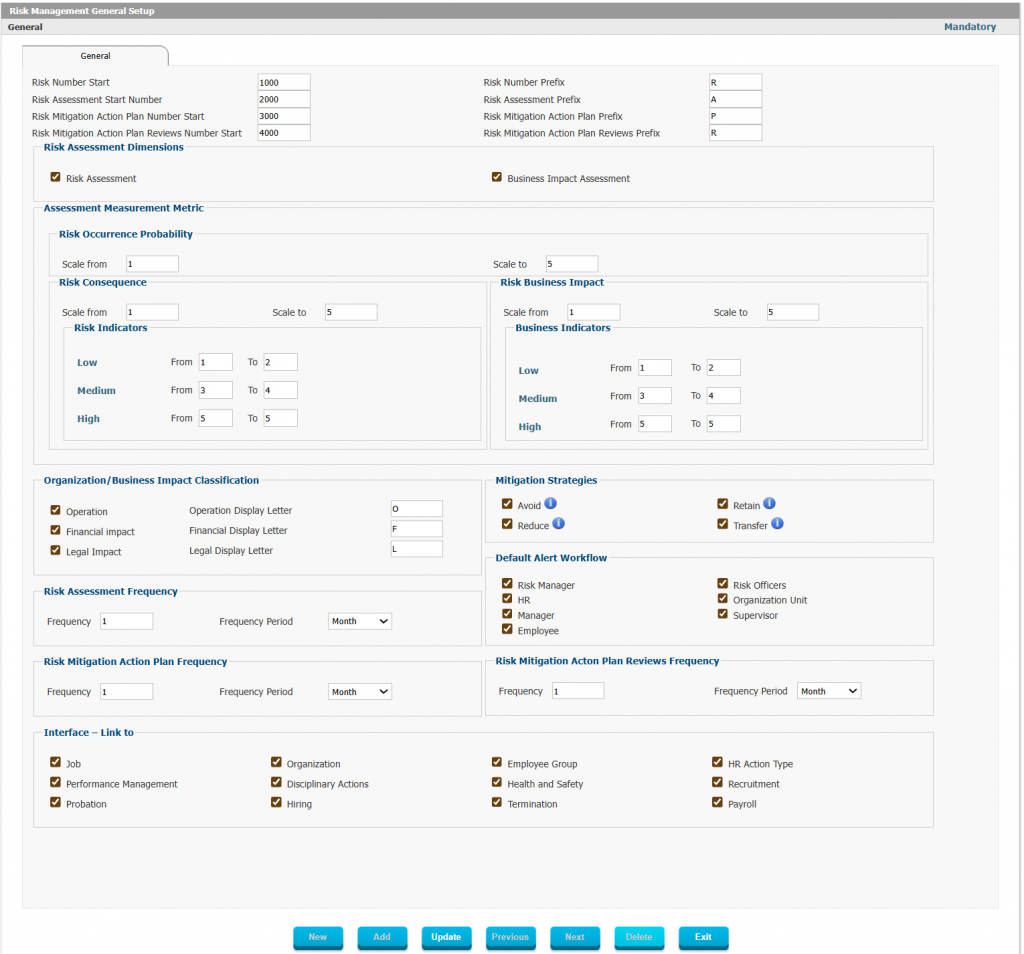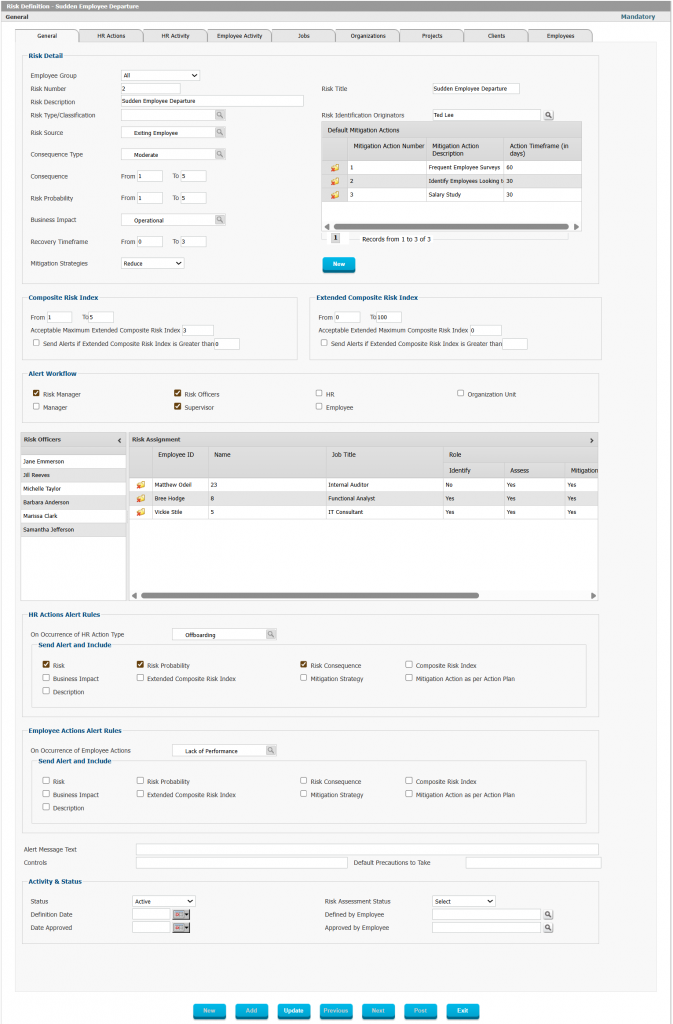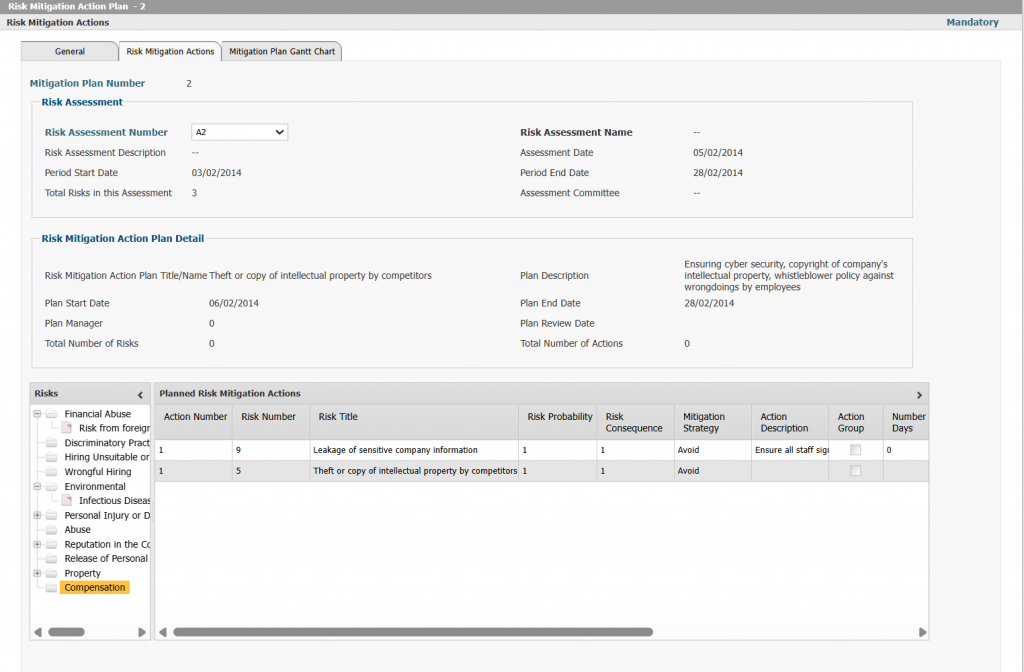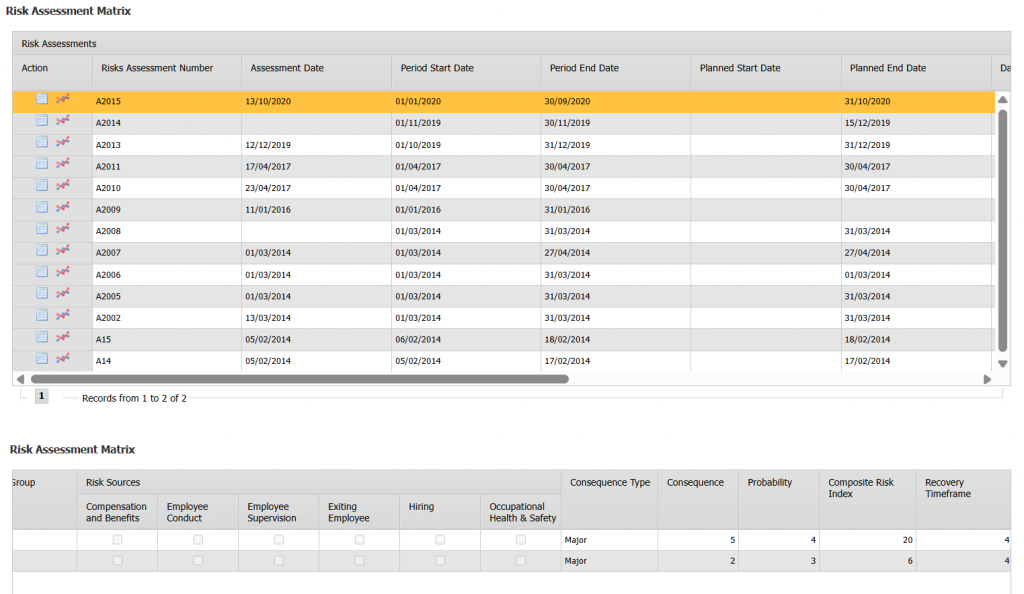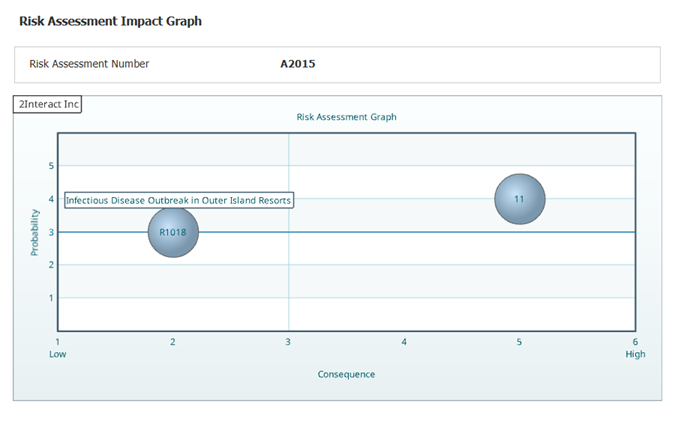Interact HRMS HR Risk Management Module Overview
Figure 1: Risk Management Setup
Figure 2: Risk Definition
Figure 3: Risk Mitigation Action Plan
Figure 4: Risk Assessment Matrix – Table
Figure 5: Risk Assessment Matrix – Graph
The Interact HRMS HR Risk Management module is a comprehensive solution designed to help organizations effectively manage risks that may impact their workforce and operations. Fully integrated with other Interact HRMS modules, this module leverages a robust framework of self-service, workflows, and alerts to ensure that all identified risks are properly assessed, tracked, and mitigated. By providing HR and risk management teams with the tools to classify, evaluate, and address risks, the HR Risk Management module supports proactive risk management and helps organizations safeguard their resources and minimize potential disruptions.
This module is particularly valuable for organizations looking to maintain a high level of risk awareness and implement structured risk mitigation strategies. By categorizing risks as operational, financial, or legal, and setting up tailored mitigation plans, organizations can address potential challenges before they escalate. Employees are empowered to report risks through self-service, and automated workflows ensure that each reported risk is reviewed by the appropriate stakeholders, including risk managers, supervisors, and HR teams.
Classification and Categorization of Risks
The HR Risk Management module includes classification capabilities that allow organizations to categorize risks according to their nature and potential impact. Risks can be classified as Operational, Financial, or Legal, ensuring that each type of risk receives the appropriate level of attention and that mitigation strategies are tailored to the specific challenges posed by each risk category.
This categorization provides clarity and focus for risk assessment and helps HR and risk management teams understand the broader implications of each risk. For instance, operational risks may involve workplace safety concerns or equipment malfunctions, while financial risks might relate to payroll errors or benefit mismanagement. Legal risks could involve regulatory compliance or employment law issues. By classifying risks in this way, the module enables organizations to prioritize mitigation efforts based on the unique demands of each risk category.
Defining Risk Mitigation Strategies
The module allows organizations to define comprehensive risk mitigation strategies to address identified risks. These strategies include:
- Avoidance: Taking measures to completely eliminate the risk by changing processes or implementing preventative actions.
- Reduction: Implementing controls to minimize the probability or impact of the risk.
- Retention: Accepting the risk as it is, usually with a plan to monitor and manage it if it occurs.
- Transfer: Transferring the risk to a third party, such as through insurance or outsourcing.
By providing these options, the HR Risk Management module enables organizations to approach risk management with flexibility, choosing the most appropriate response based on the nature and impact of each risk. Each strategy is customized to align with the organization’s overall risk tolerance and operational goals, ensuring that risk management efforts are both effective and aligned with business objectives.
Automated Alerts and Notifications for Timely Risk Response
The module includes a robust alert system that keeps all relevant stakeholders informed about reported risks and mitigation actions. Default alerts can be set up to notify the Risk Manager, HR Department, Employee Supervisor, Employee Manager, Risk Officers, Organization Unit Head, and other involved parties. These alerts ensure that risks are addressed promptly and that all necessary team members are aware of the risk status and required actions.
The alert frequency and notification criteria can be customized according to organizational needs, ensuring that stakeholders receive timely information without being overwhelmed. For example, high-priority risks may require immediate alerts, while lower-priority risks may only need periodic updates. This flexibility ensures that risk management is proactive and that attention is directed to the most critical issues.
Flexible Risk Assessment Frequency and Planning
The HR Risk Management module enables organizations to set the frequency of Risk Assessments, Risk Mitigation Action Planning, and Risk Mitigation Action Planning Reviews. This flexibility allows HR and risk management teams to tailor the assessment and review process to the organization’s specific needs and risk profile. For example, high-risk industries or departments may require more frequent assessments, while low-risk areas may only need periodic reviews.
Automatic notifications are sent to involved parties based on the defined assessment and review schedule, ensuring that all stakeholders are engaged in the risk management process. This structured approach helps organizations maintain a consistent focus on risk management, ensuring that risks are regularly reassessed and mitigation strategies are updated as needed.
Risk Assessment with Probability, Consequence, and Business Impact Indicators
The module provides a comprehensive risk assessment framework, enabling organizations to evaluate risks based on three key factors:
- Risk Occurrence Probability: The likelihood that the risk will occur.
- Risk Consequence: The potential impact or severity of the risk, with its own risk indicators.
- Risk Business Impact: The broader impact on business operations, with business risk indicators to assess the organizational implications.
These indicators allow HR and risk management teams to analyze each risk from multiple perspectives, ensuring that assessments are thorough and informed. By evaluating risks based on both probability and impact, organizations can prioritize risks and allocate resources to address those with the greatest potential impact on operations.
Employee Self-Service for Risk Identification and Reporting
The HR Risk Management module includes a self-service feature that empowers employees to identify and report risks within the organization. This feature enables employees to submit risk reports independently, creating a culture of risk awareness and accountability throughout the organization. Once a risk is reported, it is reviewed by members of the risk committee, who have access to all relevant information through the Interact HRMS portal.
This employee-driven approach to risk reporting helps organizations detect risks early, as employees are often the first to notice potential issues in their day-to-day work. By encouraging employees to participate in the risk management process, the module supports proactive risk detection and creates a safer, more resilient work environment.
Risk Assessment and Composite Risk Index Calculation
The module includes advanced risk assessment capabilities, allowing organizations to calculate a Composite Risk Index based on the assessed consequence and probability of each risk. This Composite Risk Index provides a quantitative measure of the risk level, helping organizations prioritize risks based on their severity and likelihood.
An Extended Composite Risk Index is also calculated, taking into account the Business Impact Level of the risk. This extended index provides a more comprehensive view of the risk’s potential impact on the organization, enabling decision-makers to develop targeted mitigation strategies. Based on the calculated indices, a Recovery Timeframe is determined, which specifies the expected time required to recover from the risk should it materialize. These assessments provide a structured and data-driven approach to risk prioritization and mitigation planning.
Developing and Reviewing the Risk Mitigation Strategy Plan
Once a risk has been assessed, the module generates a Risk Mitigation Strategy Plan tailored to address the specific risk. This plan includes actionable steps to mitigate the risk, aligned with the chosen mitigation strategy (avoidance, reduction, retention, or transfer). The Risk Mitigation Strategy Plan is reviewed periodically to ensure that it remains relevant and effective in addressing the risk.
The module allows organizations to set review schedules for each mitigation plan, ensuring that strategies are kept up-to-date as new information or changing conditions arise. This periodic review process helps organizations maintain a proactive stance on risk management, continuously refining mitigation strategies to minimize the impact of potential risks.
Visual Risk Assessment with Graphic Displays
The HR Risk Management module includes powerful plotting tools that enable users to visualize assessed risks in graphic displays. These visual representations make it easy for stakeholders to identify high-priority risks and monitor the effectiveness of mitigation efforts. The graphic display shows risks that require urgent attention, helping managers focus on the most critical issues and respond swiftly.
This visual approach to risk management provides an intuitive and accessible way to understand risk levels and prioritize resources. By presenting complex data in a clear, visual format, the module supports informed decision-making and enables organizations to manage risks effectively and efficiently.
Summary: Interact HRMS HR Risk Management
The Interact HRMS HR Risk Management module provides organizations with a comprehensive framework for identifying, assessing, and mitigating risks. Key benefits include:
- Classification and Categorization: Classify risks as operational, financial, or legal for targeted mitigation strategies.
- Defining Risk Mitigation Strategies: Develop customized strategies to avoid, reduce, retain, or transfer risks based on organizational needs.
- Automated Alerts for Timely Response: Set up alerts for risk managers, supervisors, and HR to ensure prompt response.
- Flexible Risk Assessment Frequency: Define the frequency of risk assessments and mitigation planning based on risk profile.
- Advanced Risk Assessment Framework: Evaluate risks with indicators for occurrence probability, consequence, and business impact.
- Employee Self-Service for Risk Reporting: Empower employees to report risks, promoting a culture of awareness and accountability.
- Composite and Extended Composite Risk Indices: Quantify risk levels for prioritization and calculate recovery timeframes.
- Risk Mitigation Strategy Plan and Review: Develop and review mitigation strategies periodically for continued relevance.
- Visual Risk Assessment: Use graphic displays to highlight high-priority risks and facilitate rapid response.
By combining these features, the HR Risk Management module supports proactive risk management, helping organizations minimize potential disruptions and protect their workforce and resources. This structured approach to risk management enhances operational resilience, supports strategic decision-making, and promotes a safe and secure working environment.


